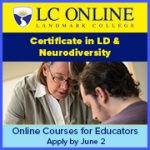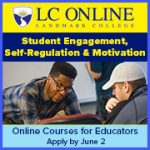 By John O. Melby
By John O. Melby
The IEP is considered by many parents, and some educators, to be one of the greatest barriers to achievement for a secondary student with a Learning Disability (LD). A student’s Individualized Education Program (IEP) focuses on the student’s deficit areas to establish needs and goals. By focusing on the deficits, the student’s strengths are most often neglected. Students with a LD will not likely get a job using their deficits (Rizga, 2015). At the secondary level, a great deal of attention is given to tutoring and remediating the disability. In the opinion of many, the IEP can become a barrier for the student to receive an appropriate education for post-secondary educational and vocational opportunities.
Currently, the main focus of the IEP is overwhelmingly on the student’s weaknesses, with perhaps a few sentences about their strengths. Many students dislike attending IEP meetings and listening to adults talk about their weaknesses and academic struggles. If we, as adults, were in a meeting where a group of adults discussed our deficits, we would not want to be there either. How often do we engage the student and ask their opinion on what they see as their needs, their strengths, or how they learn best? Do we truly include the student as a member of the IEP Team or do we leave the student thinking that the adults in the room have developed strategies and plans without input from the person affected by the IEP?
The experts in the field of LD focus on cognitive deficits and academic weaknesses for the purpose of identification of a learning disability. Assessment personnel also focus on a student’s weaknesses in their reports to determine the student’s LD eligibility. Failures on state assessments are related to these academic weaknesses. In some states, state auditors focus their audits on interventions to address these weaknesses. Therefore, the main focus of the IEP meeting is on the student’s weaknesses. When a student with a LD is forced into failure after failure because of their IEP, they tend to feel inept, shame and despair.
The neurological impairment causing the student’s LD, creates the weaknesses which are seldom fixable at the secondary level. This should be the impetus for early identification of students with a learning disability. The impairment often leads to academic failure over and over again for the skills targeted in the IEP for the secondary learner. The emphasis of the IEP at the middle school and high school levels should be about the student’s strengths, skills or attributes all of which can help lead them to success in their lives and careers. Trying to remediate student’s neurological deficits in high school most often creates additional failures for students rather than providing an appropriate education that will help them improve their lives and prepare them for their future.
Some people have a belief that if you work on one of your weaknesses it can become a personal strength. The problem with this type of belief when it comes to LD is that the LD stems from a neurobiological disorder in the brain which will not allow the weakness which it creates to ever be a personal strength. Just as Eddy’s Cerebral Palsy will never let him walk as fast as his peers, or become one of his personal strengths. If our students with LD work on personal strengths and fine tune them like an athlete who trains hard to improve their natural athletic abilities, then the students will develop their natural abilities or personal strengths, which will lead to employment opportunities that will allow them to be successful (Stuart, 2012).
For students with LD, their attributes and aptitudes will guide them to their careers. With computer generated IEPs, a comprehensive list with an overabundance of positive attributes should be available. The comprehensive lists should include, but not be limited to, positive attributes in the areas of academics, social, physical, emotional, cognitive, and occupational areas. This list should be available for parents, teachers and students to click on and select from for inclusion in the IEP. For the student with a LD, by seeing their identified attributes they may experience a sense of pride because the attributes are positive. The parents and other ARD (Admission, Review, and Dismissal) Committee members or IEP Team Members will also regard the student in a positive light. The student with LD will begin to see a path to success, which will help offset some of the parent’s fears. Currently, IEPs have two or three strengths identified; however, with a huge list of 200+ work-related positive attributes to choose from, a list of 10-20 attributes would be easy to generate. When the attributes combined with aptitudes, career interests, and aspirations the student has, then the student can then focus on a postsecondary academic or career plan. This should then be the focus of the IEP, not just part of the Transition Plan. Students with a LD should have goals which point them in a direction that coincides with their personal strengths to be successful. The IEP would then become a document that would promote success rather than failure.
The IEP meetings should develop strategies for the student with LD to better cope with their Learning Disability as opposed to attempting to fix it. No matter how many times Eddy, who has Cerebral Palsy, attends tutoring with his coach to walk faster to meet the minimal skills; he will never be able to meet the minimum standard meant for his non-disabled peers. It is not because of how hard he works, or whether or not if he wanted to, it’s because his orthopedic disability or Cerebral Palsy won’t allow him to meet the minimal skills. Alice, who has a learning disability in math reasoning, had the same problem. She was not able to meet the minimum standard meant for her non-disabled peers. It is not because of how hard she worked, or whether or not if she wanted to, it’s because her LD won’t allow her to meet the standards. Strategies need to be developed for the student with a learning disability, like Alice, to be able to cope with their LD just as Eddy did to address his mobility issues.
The strategies should include accommodations and assistive technology. By substituting classes without penalty in high school graduation plans, such as Consumer Math in lieu of Algebra for students with LD in Math Reasoning, their needs will be addressed as they steer around their deficits. Such substitutions will also enable the students to better achieve their goals and aspirations. As a colleague once said, “I wonder how many of the state legislators passed their Algebra classes in high school and still use Algebra today.”
Using a student’s positive attributes to guide the IEP, developing goals based on the student’s attributes, aptitudes, and aspirations, and developing strategies to help the student with LD succeed, will produce more positive outcomes for students with a LD. The IEP meeting would develop fewer tears and provide more hope (Moreno, 2015).
Students will begin to focus on what they can and will do to improve their academics. Parents and teachers will focus on what the student can do, which will inspire hope and understanding for the student. Helping our high school students with LD do what they are gifted to do is better than focusing on their weaknesses. I have learned through my own experiences that helping students with what they are good at is more promising than helping students learn what they are inept at, because we want them to find careers in areas where they will be successful.
John O. Melby currently works as an Educational Diagnostician with students who have learning disabilities. He grew up and pursued his education experiencing many of the same issues confronting students with learning disabilities.
References
Cramer, S.C., Mriganka Sur, Dobkin, B.H., et al, (2011). Harnessing neuroplasticity for clinical applications. BRAIN: A Journal of Neurology, 134, 1591-1609
Ivory, T. S., (2007). Improving Mathematics Achievement of Exceptional Learners through Differentiated and Peer-Mediated Instruction. ERIC Online submission. Retrieved June 2015 from http://eric.ed.gov/?q=response+to+ intervention+and+learning+disabled+secondary+students&ft=on&id=ED498376
Moreno, Elia. “EPISD Poverty in Our Schools– Living Intentionally Conference Presentation.” EPISD Connect: Championing Special Education Students’ Success. El Paso Marriott, El Paso, Texas. 19 August 2015. Keynote Address.
Rizga, K. (2015). Sorry, I’m Not Taking This Test. Mother Jones, 40(5), 38-43, 62-64.
Stuart, G. (2012). What is the Strengths Perspective? Sustaining Community. [Web log comment]. Retrieved August 2015 from https://sustainingcommunity. wordpress.com/2012/05/30/what-is-the-strengths-perspective


